In Spanish, the imperative mood (imperativo) is used for giving commands. The imperative is always conjugated in the present tense and omits the personal pronoun. The imperative exists in five main forms: (tú) ¡habla! (speak!), (used) ¡hable! (speak!), (nosotros) ¡hablemos! (vosotros) ¡hablad! and (ustedes) ¡hablen! This post will explain precisely how to conjugate and use the Spanish imperative mood. ¡Sigue liendo! Keep reading!
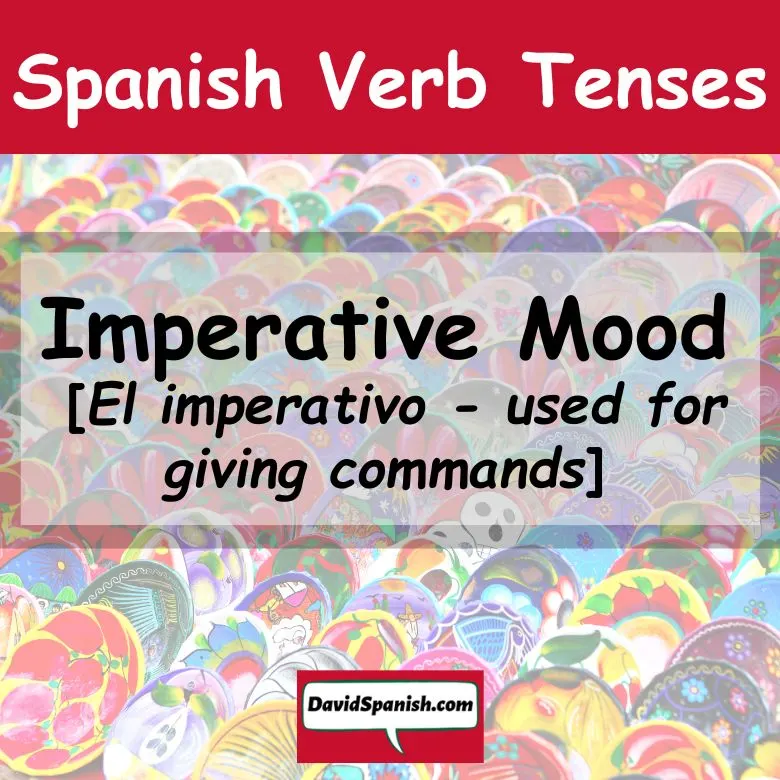
Guide to the Spanish imperative mood
Examples of how to use the impertive in Spanish
In Spanish, the imperative is used to make suggestions and suggest plans. For example:
- ¡Vamos a la playa! Let’s go to the beach!
The second most important usage of the imperative is to give orders. For example:
- ¡Déme mi dinero! Give me my money!
A third common usage is for offering advice. For example:
- Si posible, aprende epañol. If possible, learn Spanish.
The fourth most common use of the imperative is for making requests. For example:
- Ayudame con mi maleta, por favor. Help me with my suitcase, please.
Note that the above sentence can also be written with the conditional tense.
- ¿Podría ayudarme con mi maleta, por favor? Could you help me with my suitcase, please?
A fifth common usage of the imperative is for making points in conversation. For example:
- Oye, no estoy de acuerdo. Listen, I don’t agree.
- Mira, no es una buena idea. Look, it’s not a good idea.
How to conjugate the imperative mood in Spanish
As mentioned above, the imperative can be conjugated in five forms: tú (you singular/informal), usted (you formal), nosotros (we), vosotros (you plural for Spain) and ustedes (you plural).
For the group of regular verbs, we’ll use the following verbs in the tables below: hablar (to speak), comer (to eat) and escribir (to write).
Tú – second-person singular
In Spanish, use tú for individual people who you know and children. In the affirmative command, the imperative for the tú form is the same 3rd person in the present tense (also called the present indicative). To form a negative command in for tú form, use the 2nd person of the present subjunctive form.
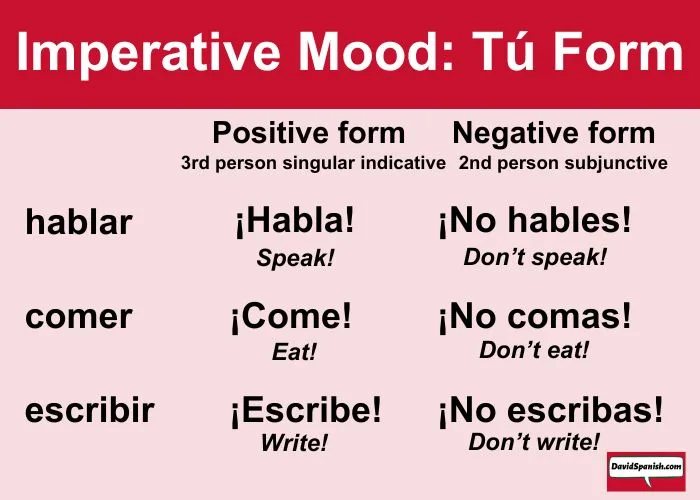
Usted – third-person singular
Both the positive and negative conjugations in the usted (polite form for you) are the same: The third-person singular of the subjunctive.
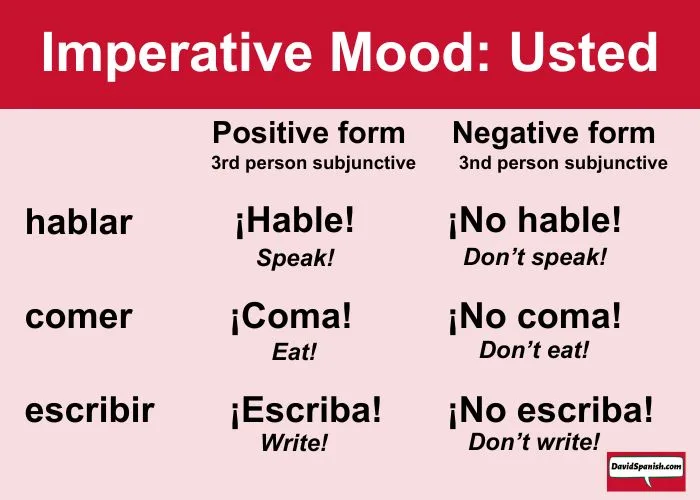
Nosotros/as – first-person plural
For nosotros/as (we), use the first-person plural of the subjunctive to form the imperative.
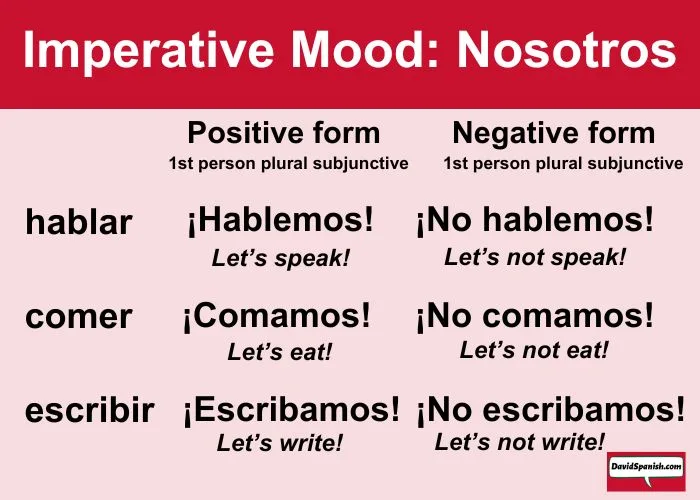
Ustedes – second person plural
For ustedes, use the 3rd person plural form of the subjunctive.
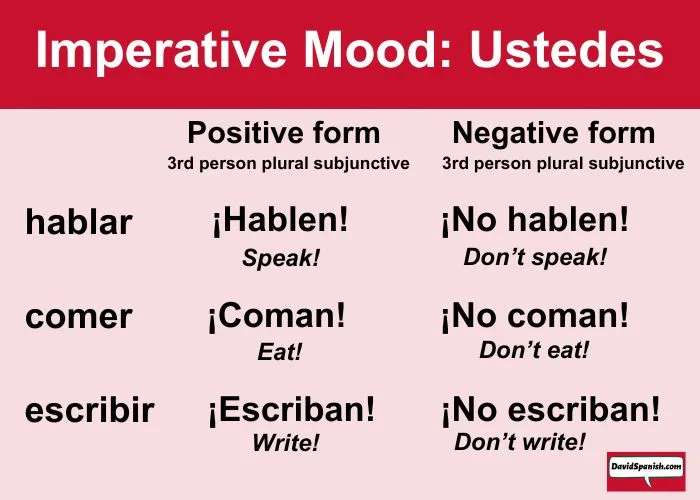
Vosotros – 2nd person plural
For the postive form of vosotros/as (you plural in Spain), replace the -r on the infinitive with -d. For the negative form, use the present subjunctive.
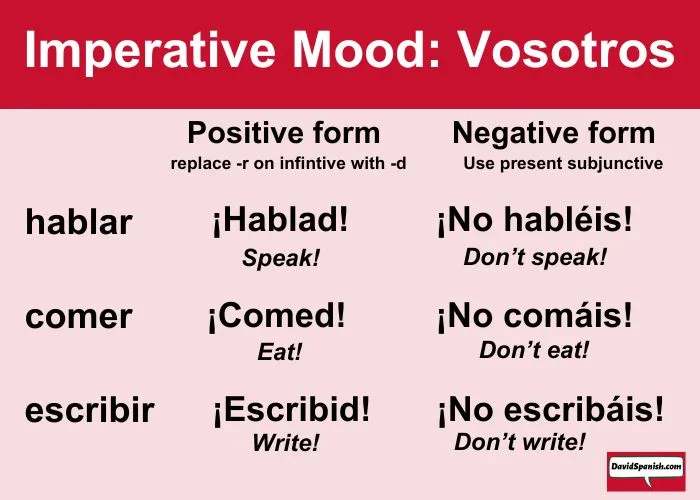
Imperative mood for irregular verbs
Many irregular verbs also have irregular forms in the imperative. Below we’ll list the forms for tu and usted as these are used the most in conversation.
Irregular verbs – tú
Just like the regular verbs listed above, the conjugations change for tú in the affirmative and negative forms.
- ser (to be): ¡sé! / ¡no seas!
- estar (to be): ¡está! / ¡no estés!
- decir (to say): ¡di! / ¡no digas!
- ir (to go): ¡ve! / ¡no vayas!
- hacer (to make, do): ¡haz! / ¡no hagas!
- tener (to have) ¡ten! / ¡no tengas!
- poner (to put): ¡pon! / ¡no pongas!
- venir (to come): ¡ven! / ¡no vengas!
Irregular verbs – usted
These same irregular verbs are much easier in the usted form as their conjugations don’t change.
- ser (to be): ¡sea! / ¡no sea!
- estar (to be): ¡esté! / ¡no esté!
- decir (to say): ¡diga! / ¡no diga!
- ir (to go): ¡vaya! / ¡no vaya!
- hacer (to make, do): ¡haga! / ¡no haga!
- tener (to have) ¡tenga! / ¡no tenga!
- poner (to put): ¡ponga! / ¡no ponga!
- venir (to come): ¡venga! / ¡no venga!
Here are some example using irregular verbs in the imperative mood:
- ¡Haz tu tarea! Do your homework!
- ¡No haga pendejadas! Don’t do stupid things!
- ¡Venga con migo! Come with me.
- ¡No tengas miedo! Don’t be scared
- ¡Diga la verdad! Tell the truth!
Irregular verbs – nosotros
As mentioned above, in the nosotros form, the imperative implies “let’s” in English. A few verbs are necessary to know.
- ir (to go): ¡vamos! / ¡no vayamos!
- ser (to be): ¡seamos! / ¡no seamos!
- hacer (to make, do): ¡hagamos! / ¡no hagamos!
Here are some examples:
- ¡No vayamos esta noche! Let’s not go tonight.
- ¡Hagamos un pastel! Let’s make a cake!
- ¡Seamos razonables! Lets’ be reasonable.
Imperative With Single Object Pronouns
When making a positive command, the direct object pronoun is treated as a suffix and is attached to the verb. For example:
- ¡Comelo! Eat it!
- ¡Ayudame! Help me!
For negative commands, the direct object pronoun comes before the verb:
- ¡No lo comas! Don’t eat it!
- ¡No me ayudes! Don’t help me!
The imperative and double object pronouns
In some sentences you will find both a direct and indirect pronoun. In the following example el helado (the ice cream) and is the object of the sentence itself and para ella (for her) is the indirect object and indicates for whom the object is aimed.
- ¡Compra el helado para ella! Buy an ice cream for her.
In the next sentence, para ella is written with the indirect object, le.
- ¡Comprale un helado! Buy her an ice cream!
Normally the indirect object “for her” would be le. However, in a sentence with two object pronouns, the le becomes se.
- ¡Compraselo! Buy it for her!
- ¡No se lo compra! Don’t buy it for her!
Conclusion
We hope this post has helped you to gain a grasp of the Spanish imperative mood. Study the verbs – ¡Estudialos! Study them!
Discover more:
- La Bamba Meaning, Spanish Lyrics & English Translation - May 4, 2024
- Bésame Mucho Meaning, Spanish Lyrics & English Translation - May 3, 2024
- Querida – Lyrics, Meaning & Translation - May 2, 2024
